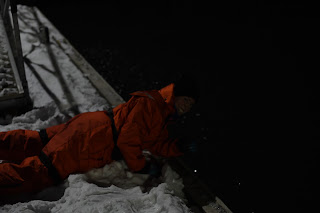Holdfasts
After discovering that the larval community in Kongsfjorden was skewed toward diversity, Kharis and I came up with a different strategy to find hundreds of larvae of the same species. If we collected reproductive adults, they might spawn in the lab and give us the monolithic cohort we were looking for. So we headed to the dock with buckets in hand to look for reproductive adults.
We weren't sure what - or rather, who - we were going to find. Our experiments will work with any species, as long as the larvae are planktotrophic (i.e., rely on external food sources rather than yolk from their mothers). Clams, snails, sea slugs, or bryozoans could have fit the bill. We just needed someone who was ready to release their young.
 |
| Belly Biology in the polar night. Photo by Kharis Schrage. |
That's right, kelp grows on the dock in Ny-Ålesund. I was pretty surprised to find there was anything on the dock at all, to be honest. Shallow Arctic communities are damaged by ice scour, so very little grows there. I'm not exactly sure how the kelp on the dock survive, but I was grateful for them all the same. Kelp have holdfasts, and holdfasts play host to a community of invertebrates.
The holdfast is the part of the kelp that attaches to the seafloor. It kind of looks like roots, but it's much simpler and totally exposed. The complex, winding spaces between the branches of the holdfast create shelter for animals like hydroids, bryozoans, and nudibranchs. They're nice little habitats that you can hold in your hand.
 |
| Hydroids living on a kelp holdfast. Photo by Kharis Schrage. |
Our excursion to the dock was a fun tangent to our research. Let's hope those nudibranchs spawn!
Comments
Post a Comment